Dallas (214) 340-8885
Athens (903) 677-9090
Gun Barrel City (903) 887-4341
Dallas (214) 340-8885
Athens (903) 677-9090
Gun Barrel City (903) 887-4341
Bunions are a common ailment, especially for women. Hallus vaxus, or bunions are a bump at the base of your big toe caused a combination of genetics and poor shoes.
Wife of famous soccer star David Beckham, Victoria Beckham suffers from severe bunions caused by many years of wearing high heels, both on and off the red carpet Beckham had a bunionectomy to remove the bunions and realign her toes.
Dr. Jonathan Kletz is a podiatrist who specializes in helping people suffering from Bunions.
How do I get bunions?
Although experts debate the causes, it seems that there are several ways that bunions can develop. It has been proved that wearing pointy-toed shoes is possibly a factor in the inflammation of the joint. Recently, certain studies have shown that the affliction might hold some genetic roots in it, since girls whose mothers had bunions seem to be more likely to develop the disorder.
What can I do to treat my bunions?
A simple examination by the doctor is usually enough to diagnose bunions, but most often, there will be an X-Ray to confirm the diagnosis.
There are several remedies that are available to those who have bunions. Depending on the severity of the condition, there are both surgical and non-surgical remedies available. For select patients, orthotics that help distribute pressure evenly across your feet and elevate your arches might be beneficial.
Avoiding uncomfortable shoes can prevent unnecessary confinement that can further irritate bunions. If you apply ice to the bunion, it can provide a temporary sense of relief by reducing inflammation and soreness.
For patients suffering from more severe bunions, a bunionectomy might be the best course of treatment. There are a few different options when looking at surgery to treat bunions, a few of which include:
Texas Foot Works located in Dallas, Athens and Gun Barrell City, TX, we specialize in helping people suffering from bunions. To schedule an appointment, call 214-340-8885.
One of the top ten diseases in United States is diabetes. Over 29 million Americans suffer from diabetes, with a few more famous diabetics being novelist Anne Rice, Supreme Court Justice Sonya Sotomayor and pop culture icon, Nick Jonas.
Diabetic foot care is of critical importance, since diabetes can cause lack of blood flow in the legs and feet, resulting in numbness and loss of feeling. Due to the numbness, cuts and sores go unnoticed, which leads to infection. This means that diabetics need to spend a little extra time paying attention to their feet so they can remain healthy. Dr. Jonathan Kletz is a podiatrist who specializes in helping people with diabetes.
How do I take care of my feet if I am a diabetic?
Wash and dry your feet on a daily basis
Wash your feet gently in warm water using soap and mild water, but don’t soak them, since that will dry the skin on your feet. Use lotion on the bottom of your feet to prevent cracking and for preventing infections between your toes, using talcum powder generally works well.
Keep your feet covered at all times
People with diabetes need to make sure not to go barefoot- it is important to always wear shoes and socks, since diabetics cannot necessarily feel if they step on something sharp. Make sure your shoes are empty before putting them on- look in them to ensure that no foreign objects are in there that could possibly cut you.
Trim your toenails regularly
If you can comfortably see and reach your feet, keep your toenails trimmed. However, if your toenails are thick or yellowed, if you cannot reach your feet, or if you cannot feel your feet, have your podiatrist cut your toenails for you.
Keep the blood flowing to your feet
Don’t wear socks or shoes that cut off your circulation to your feet and legs or are too tight. Do not cross your legs for extended periods of time, and keep your feet elevated when sitting down.
Check your feet every day
Make sure you examine your feet every day for infected toenails, swelling, cuts or sores. If you have difficulty seeing your feet, use a mirror or ask a family member/caregiver to help you out.
Texas Foot Works located in Dallas, Athens and Gun Barrell City, TX, we specialize in helping people with diabetes. To schedule an appointment, call 214-340-8885.
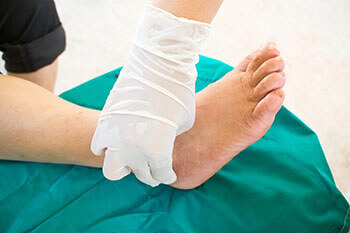 Diabetics must be wary of all wounds, regardless of depth or size. Diabetes, a chronic disease in which the body cannot properly use glucose the way it normally would, causes various complications that make wounds difficult to heal. Nerve damage or neuropathy will cause diabetics to have trouble feeling the pain of a blister or cut until the condition has significantly worsened or become infected. A diabetic’s weakened immune system can make even the most minor of wounds easily susceptible to infection. Diabetics are also more prone to developing narrow, clogged arteries, and are therefore more likely to develop wounds.
Diabetics must be wary of all wounds, regardless of depth or size. Diabetes, a chronic disease in which the body cannot properly use glucose the way it normally would, causes various complications that make wounds difficult to heal. Nerve damage or neuropathy will cause diabetics to have trouble feeling the pain of a blister or cut until the condition has significantly worsened or become infected. A diabetic’s weakened immune system can make even the most minor of wounds easily susceptible to infection. Diabetics are also more prone to developing narrow, clogged arteries, and are therefore more likely to develop wounds.
Wounds should be taken care of immediately after discovery, as even the smallest of wounds can become infected if enough bacteria build up within the wound. To remove dirt, wounds should be first rinsed under running water only. Soap, hydrogen peroxide, or iodine can irritate the injury and should be avoided. To prevent infection, apply antibiotic ointment to the wound and cover it with a bandage. The bandage should be changed daily. The skin around the wound may be cleaned with soap.
To prevent further exacerbation, see a doctor—especially if you have diabetes. Minor skin conditions can become larger problems if not properly inspected. As the wound heals, make sure to avoid applying pressure to the affected area.
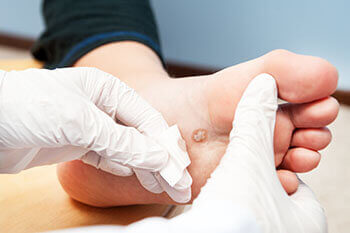 Plantar warts are warts that are only found on the feet, hence the term “plantar”, which means “relating to the foot.” They are caused by the human papillomavirus, or HPV, and occur when this virus gets into open wounds on the feet. The warts themselves are hard bumps on the foot and easily recognizable, mostly found on the heels or ball of the foot. For the most part, plantar warts are non-malignant, but they can cause some pain, discomfort, and are often unsightly, so removing them is often the first step taken.
Plantar warts are warts that are only found on the feet, hence the term “plantar”, which means “relating to the foot.” They are caused by the human papillomavirus, or HPV, and occur when this virus gets into open wounds on the feet. The warts themselves are hard bumps on the foot and easily recognizable, mostly found on the heels or ball of the foot. For the most part, plantar warts are non-malignant, but they can cause some pain, discomfort, and are often unsightly, so removing them is often the first step taken.
Plantar warts can cause some pain while standing, sometimes felt as tenderness on the sole of your foot. Unless the wart has grown into the foot behind a callus, you will be able to see the fleshy wart. Because plantar warts are not cancerous or dangerous, a podiatrist should only be consulted if there is an excess amount of pain associated with having them, if they are affecting your walking, or if they continually come back. However, anyone who suffers from diabetes or a compromised immune system disease should seek out care immediately.
Podiatrists are easily able to diagnose plantar warts. They usually scrape off a tiny bit of the rough skin in order to make tiny blood clots visible and show the inside of these warts. However, a biopsy can be done if the doctor is not able to diagnose them from simply looking at them. For a less invasive treatment option, topical creams can be used through a doctor’s prescription, which may help given enough time and patience. Keep the wart covered for protection in between daily treatments.
The best way to avoid developing plantar warts is to avoid walking barefoot in public places, especially when you have open sores or cuts on your feet. It is also important to avoid direct contact with any other warts you might have or warts other people might have, as they are highly contagious.
 The plantar fascia is a connective tissue in the heel that stretches the bottom length of your foot. Plantar fasciitis is the inflammation of this connective band, causing heel pain and overall discomfort while walking or standing. Although the condition is completely treatable, traditional methods can take up to a year to start being effective.
The plantar fascia is a connective tissue in the heel that stretches the bottom length of your foot. Plantar fasciitis is the inflammation of this connective band, causing heel pain and overall discomfort while walking or standing. Although the condition is completely treatable, traditional methods can take up to a year to start being effective.
Plantar fasciitis is caused by a number of everyday activities, so understanding and assessing the condition is paramount to managing and treating it. One of the most common causes of plantar fasciitis is excessive running, especially with improper fitting or non-supportive shoes. By over exercising and running, the plantar fascia gets overworked and overstretched, eventually causing tears in the tissue and inflammation. Along with improper fitting shoes, over-pronation is a common cause of plantar fasciitis. By not having the right shoes to correct this issue, once again the plantar fascia becomes overstretched and starts to tear, causing the inflammation.
Despite the common causes of plantar fasciitis, there are many different treatment options. For less severe cases, conservative home remedies such as taking anti-inflammatory drugs to alleviate pain, applying ice packs to the bottom of your foot and heel, slowly stretching and exercising your feet to re-strengthen the tissue, and using orthotic devices to overcome issues such as over-pronation are all ways to help manage your plantar fasciitis.
For more severe cases however, there are still things that can be done. Shockwave therapy has become a common solution for plantar fasciitis because it effectively breaks up the tissue on the bottom of your foot via sound waves which facilitates healing and regeneration, allowing you to overcome the chronic pain caused by plantar fasciitis. Even if this doesn’t work, surgery is always a final option. Surgery on the tissue itself can be done to permanently correct the issue and stop the inflammation and pain is your heels.
No matter what the case may be however, seeking the immediate care of your podiatrist is the first and best step to recovery. Even the slightest amount of heel pain could be the first stages of plantar fasciitis and the initial onset of tearing and overstretching of that band of tissue. On top of this, because the tearing of this tissue can be compounded if it remains ignored, it could become a more severe case than it needs to be. The solution to this is early detection and early treatment, so be sure to talk to your podiatrist about the possibilities of plantar fasciitis if you’re experiencing heel pain.
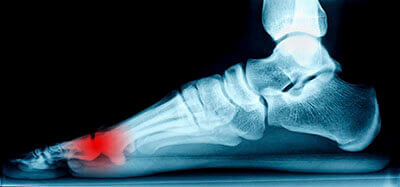 An ingrown toenail is caused when a toenail grows sideways into the bed of the nail, causing pain and swelling. The nail can sometimes exacerbate and become infected, creating serious drainage.
An ingrown toenail is caused when a toenail grows sideways into the bed of the nail, causing pain and swelling. The nail can sometimes exacerbate and become infected, creating serious drainage.
There are many risk factors that can predispose a person to this common condition. Cutting your nails too short, participating in sports, diabetes, being overweight, or having a fungal infection of the toe can all cause an ingrown toenail. The condition can often be related to genetics, as many people are genetically predisposed to ingrown nails. More often than not, the problem can arise from wearing ill-fitting shoes or from shoes that keep the feet slightly damp.
To prevent ingrown toenails, allow your toenails to grow a little longer and avoid cutting them too short. If you do develop an ingrown nail, soaking the toe in hot water will help prevent infection and lessen pain. You may want to add antibiotic soap or Epsom salts to the water, which will provide further protection against infection.
There are many quick treatments available for ingrown toenails that can lessen pain and have you walking with comfort. If your pain is so severe that it keeps you from everyday activities, however, a visit with your podiatrist is necessary.
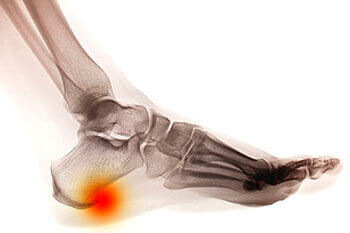 Heel spurs are essentially a hook of bone that forms at the back of the foot, at the base of the ankle. Heel spurs are also described as a calcium deposit that covers the tendons and ligaments of the ankle. Heel spurs cause extreme pain, and can prevent someone from walking or being physically active at a normal level.
Heel spurs are essentially a hook of bone that forms at the back of the foot, at the base of the ankle. Heel spurs are also described as a calcium deposit that covers the tendons and ligaments of the ankle. Heel spurs cause extreme pain, and can prevent someone from walking or being physically active at a normal level.
Heel spurs are more common than people expect them to be. They are most common in people age forty and over, although heel spurs can occur in people younger than forty, and frequently affect athletes or people who are very physically active. Heel spurs are also common in those with poor circulation and degenerative diseases. People who suffer from arthritis may suffer from heel spurs as well.
The symptoms of heel spurs are pain in the lower ankle, which increase when walking.
Treatment of heel spurs can be treated many ways and most often times is very effective. If someone suspects that they have heel spurs, they should contact their physician. Their physician will recommend that they perform an x-ray on the patient's ankles. The physician may also perform a physical on the patient to ensure that there are no underlying conditions, and of course if heel spurs are discovered a physician can recommend treatment options.
Orthopedic shoes are specially designed footwear for people who suffer with foot problems. Orthopedics offer a rubber sole, which cushions the heel and adds comfort to those who suffer from heel spurs. Another simple way to help the pain of heel spurs is to elevate the ankle to diminish the pain. When elevating the ankle, the blood is not focused on that area of the foot and can bring some relief. When all these options have been attempted, and there is still no relief from heel spurs, or the heel spurs return, surgery can be the more dramatic and permanent way to rid patient of heel spurs.
There are less conventional ways that are becoming more popular ways to treat heel spurs. One option would be to use a night splint which reduces the pain caused from heel spurs if worn overnight. Other alternative treatment methods that can be used are ultrasound, or acupressure. There are also other tolls that can be used are heel cups, heel seats, heel pads, arch supports, and insoles.
Exercise is also another powerful tool to help alleviate pain from heel spurs and can help in dealing with some of the symptoms, although exercising incorrectly and forgetting to protect your feet can lead to further pain. It is important to remember the correct way to place the feet when exercising so as to avoid making the problems worse, or creating problems. When exercising to alleviate heel spurs, exercising strengthens muscles around the surrounding tissue around the ankle. Stretching will also keep the tendons around the ankle flexible.
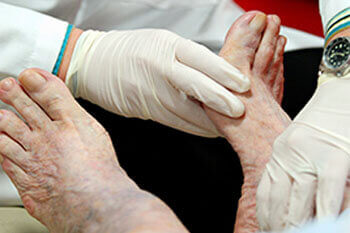 While proper foot care is important for everybody, senior citizens have the tendency to be more susceptible to certain conditions and should therefore be well informed about problems that may arise and what they can do to properly avoid or treat them.
While proper foot care is important for everybody, senior citizens have the tendency to be more susceptible to certain conditions and should therefore be well informed about problems that may arise and what they can do to properly avoid or treat them.
Some of the most common problems are foot ulcers, ingrown toenails, fallen arches, and fungal infection. A foot ulcer is an open sore on the foot and can be a result of decreased sensation in the feet. An ingrown toenail is defined as when the nail grows into the side of the toe. Fallen arches are indicated by the instep of the foot collapsing. A fungal infection is a condition that results in deformed and discolored toenails.
In order to avoid these conditions it is recommended that the feet be inspected by the patient on a regular basis. If these inspections are carried out routinely, there is a good likelihood that problems can be identified before they become severe, or can even be avoided altogether. If any abnormality is discovered, it is important that the individual consult a doctor for diagnosis and information on treatment options.
Proper foot hygiene is also important. Making sure that you always have clean, dry socks on can be a major deterrent to many different problems including bacterial infections, foot odor, and certain types of fungus. Wet feet are a major cause of many of these problems. If your socks get wet, it is important to change them. Walking around in wet socks may not only lead to various infections, but can irritate the skin and result in a number of various complications. Clean, dry feet are less likely to be affected by fungal and other infections.
As people age, the fat present on your feet begins to deteriorate. The protective nature of this fat keeps the feet healthy by providing a barrier and between your bones and the ground as well as giving the skin on the foot a certain amount of elasticity. This is one factor that causes elderly people to develop some serious foot issues. Foot moisturizers can be helpful to avoid certain problems associated with this.
However, water-based moisturizers do not work as well for elderly people as they do for the young. Instead, it is more effective to use an emollient instead. An emollient is effective because it binds the water in the foot, keeping it from becoming absorbed too readily which will result in dry skin. They also have a special property called occlusion, which provides a layer of oil on the skin. This layer prevents the foot from drying up and can be very effective in treating dry skin disorders. If you can keep the skin on your feet healthy, this will substantially reduce the number of foot problems you will encounter in old age.
Proper footwear is another way to keep feet healthy. Shoes that fit well and provide proper support help prevent ingrown toenails and fallen arches.
Certain medical conditions such as diabetes or poor blood circulation increase the risk for foot issues. For individuals with any of these conditions it is extremely important to conduct regular foot inspections to make sure that there are no sores or infections present.
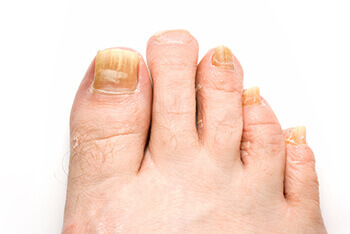 HyperBlue Laser
HyperBlue Laser
Laser surgery in podiatry is used to treat conditions such as warts, ingrown nails, infected or fungal nails, and various other skin conditions of the foot. Many patients opt for lager surgery as opposed to something that is more invasive to avoid the side effects that can often result from using a scalpel. The HyperBlue laser is one such system.
The light from the laser vaporizes the tissues that are affected with the condition nearly immediately. Lasers also have the added benefit of being accurate and precise. Aside from destroying the affected tissue, the laser also sterilizes and stops bleeding in the surrounding areas. Recovery after laser surgery is typically faster, with the patient having to suffer less pain and discomfort.
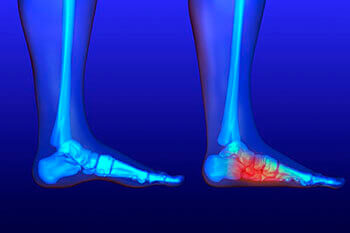 Flat feet is a condition in which the arch of the foot is depressed, generally making the sole of the foot completely or almost completely stay in contact with the ground. About 20-30% of the population generally has flat feet because their arch never formed during growth.
Flat feet is a condition in which the arch of the foot is depressed, generally making the sole of the foot completely or almost completely stay in contact with the ground. About 20-30% of the population generally has flat feet because their arch never formed during growth.
Having flat feet can sometimes make it difficult to walk due to the stress it places on the ankles. The general alignment of your legs is thrown off because the ankles move more inward which can cause some major discomfort. This also has a big effect on the knees as many people that have flat feet often have arthritis in that area. However, in many cases, having flat feet do not cause any pain and it should not be a cause for concern in that case.
For those that run, there are specific shoes to help realign the ankles with a lot more support and less pronation. The weight shifting in this activity is very quick, so that's why it's important to know if you have flat feet early on in your life, in case of injury down the road.
Symptoms of flat feet can include: pain around the heel or arch area, trouble standing on the tip toe, swelling around the inside of the ankle, flat look to one or both feet, and having your shoes feel uneven when worn. A major cause of flat feet is never having developed an arch on your foot. Overtime, a lot of stress and trauma to the foot can actually weaken the posterior tibial tendon that runs around the inside of the ankle. This is the reason why some people with flat feet have pain around that particular area.
There are a number of ways to help treat flat feet. One way is going barefoot. Studies have shown that those that grew up going barefoot or wearing less closed-toe shoes actually have more of an arch because the general strength and fullness of the arch increased. Also, those with flat feet have a weaker Achilles tendon, and exercise to the area will help stretch the area. In a lot of cases, there are great shoe inserts provided by orthopedists to provide ankle support as well as reduce the symptoms that go along with severe flat feet. For those that suffer severe pain in that area, tendon surgery is an option to help with any posterior tibial tears.